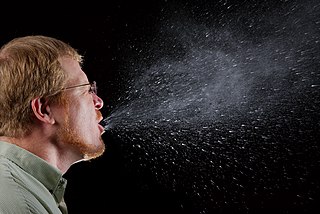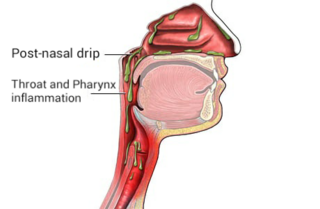Mechanism
Throat clearing is a sound made at the back of the throat. [3] The act of clearing the throat causes the folds in the throat to vibrate similar to a cough so it may be harmful if it is continuously practiced. [4]
Throat clearing is forcibly, sometimes mutedly, expelling air from one's lungs, sometimes to clear mucus, sometimes to attract attention to something. It is less vigorous than coughing.
Throat clearing may be articulated consciously or unconsciously, and may be a symptom of a number of laryngopharyngeal (upper respiratory tract) ailments. [1] Occasionally the cause is a common cold or post-nasal drip. The nose dispatches mucus which is meant to assist clearing infections and allergens. Mucus which is thick is forced out with a throat clearing sound. Another cause is laryngopharyngeal reflux. [2]
Throat clearing is a sound made at the back of the throat. [3] The act of clearing the throat causes the folds in the throat to vibrate similar to a cough so it may be harmful if it is continuously practiced. [4]
When the pressure is restricted with a closed mouth, as is common in polite society, the sound is articulated as a single-syllable exclamation, written onomatopoeiacally as "hem"; [5] or it may be articulated as a double-syllable sound, written as "ahem", which is expressed by inhaling slightly and then exhaling more forcibly. An alternate onomatopoeia written "hock" or "hawk" (as in "to hock a loogie") represents the impolite sound of loudly expelling a bolus of sputum with an open mouth. [6]
A deliberately executed throat clearing can be a nonverbal, paralingual form of metacommunication. [7] A loud, exaggerated throat-clearing noise may sometimes be used to get attention; as in the case of a parent signaling to a child that they should behave. [8]

The larynx, commonly called the voice box, is an organ in the top of the neck involved in breathing, producing sound and protecting the trachea against food aspiration. The opening of larynx into pharynx known as the laryngeal inlet is about 4–5 centimeters in diameter. The larynx houses the vocal cords, and manipulates pitch and volume, which is essential for phonation. It is situated just below where the tract of the pharynx splits into the trachea and the esophagus. The word 'larynx' comes from the Ancient Greek word lárunx ʻlarynx, gullet, throat.ʼ

The uvula, also known as the palatine uvula, is a conic projection from the back edge of the middle of the soft palate, composed of connective tissue containing a number of racemose glands, and some muscular fibers. It also contains many serous glands, which produce thin saliva. It is only found in humans.
An interjection is a word or expression that occurs as an utterance on its own and expresses a spontaneous feeling or reaction. It is a diverse category, encompassing many different parts of speech, such as exclamations (ouch!, wow!), curses (damn!), greetings, response particles, hesitation markers, and other words. Due to its diverse nature, the category of interjections partly overlaps with a few other categories like profanities, discourse markers, and fillers. The use and linguistic discussion of interjections can be traced historically through the Greek and Latin Modistae over many centuries.

A cough is a sudden expulsion of air through the large breathing passages which can help clear them of fluids, irritants, foreign particles and microbes. As a protective reflex, coughing can be repetitive with the cough reflex following three phases: an inhalation, a forced exhalation against a closed glottis, and a violent release of air from the lungs following opening of the glottis, usually accompanied by a distinctive sound.

A sneeze is a semi-autonomous, convulsive expulsion of air from the lungs through the nose and mouth, usually caused by foreign particles irritating the nasal mucosa. A sneeze expels air forcibly from the mouth and nose in an explosive, spasmodic involuntary action. This action allows for mucus to escape through the nasal cavity. Sneezing is possibly linked to sudden exposure to bright light, sudden change (drop) in temperature, breeze of cold air, a particularly full stomach, exposure to allergens, or viral infection. Because sneezes can spread disease through infectious aerosol droplets, it is recommended to cover one's mouth and nose with the forearm, the inside of the elbow, a tissue or a handkerchief while sneezing. In addition to covering the mouth, looking down is also recommended to change the direction of the droplets spread and avoid high concentration in the human breathing heights.

Phlegm is mucus produced by the respiratory system, excluding that produced by the throat nasal passages. It often refers to respiratory mucus expelled by coughing, otherwise known as sputum. Phlegm, and mucus as a whole, is in essence a water-based gel consisting of glycoproteins, immunoglobulins, lipids and other substances. Its composition varies depending on climate, genetics, and state of the immune system. Its color can vary from transparent to pale or dark yellow and green, from light to dark brown, and even to dark grey depending on the constituents. The body naturally produces about 1 quart of phlegm every day to capture and clear substances in the air and bacteria from the nose and throat.

Laryngitis is inflammation of the larynx. Symptoms often include a hoarse voice and may include fever, cough, pain in the front of the neck, and trouble swallowing. Typically, these last under two weeks.
Paralanguage, also known as vocalics, is a component of meta-communication that may modify meaning, give nuanced meaning, or convey emotion, by using techniques such as prosody, pitch, volume, intonation, etc. It is sometimes defined as relating to nonphonemic properties only. Paralanguage may be expressed consciously or unconsciously.
Catarrh is an inflammation of mucous membranes in one of the airways or cavities of the body, usually with reference to the throat and paranasal sinuses. It can result in a thick exudate of mucus and white blood cells caused by the swelling of the mucous membranes in the head in response to an infection. It is a symptom usually associated with the common cold, pharyngitis, and chesty coughs, but it can also be found in patients with adenoiditis, otitis media, sinusitis or tonsillitis. The phlegm produced by catarrh may either discharge or cause a blockage that may become chronic.

Post-nasal drip (PND), also known as upper airway cough syndrome (UACS), occurs when excessive mucus is produced by the nasal mucosa. The excess mucus accumulates in the back of the nose, and eventually in the throat once it drips down the back of the throat. It can be caused by rhinitis, sinusitis, gastroesophageal reflux disease (GERD), or by a disorder of swallowing. Other causes can be allergy, cold, flu, and side effects from medications.
The term loogie is typically used to refer to sputum, a mixture of phlegm and nasal mucus expectorated from the throat by coughing. It may also refer to:

Rhinorrhea, rhinorrhoea, or informally runny nose is the free discharge of a thin mucus fluid from the nose; it is a common condition. It is a common symptom of allergies or certain viral infections, such as the common cold or COVID-19. It can be a side effect of crying, exposure to cold temperatures, cocaine abuse, or drug withdrawal, such as from methadone or other opioids. Treatment for rhinorrhea may be aimed at reducing symptoms or treating underlying causes. Rhinorrhea usually resolves without intervention, but may require treatment by a doctor if symptoms last more than 10 days or if symptoms are the result of foreign bodies in the nose.

Parasitic bronchitis, also known as hoose, husk, or verminous bronchitis, is a disease of sheep, cattle, goats, and swine caused by the presence of various species of parasite, commonly known as lungworms, in the bronchial tubes or in the lungs. It is marked by cough, dyspnea, anorexia and constipation. Lungworms which cause parasitic bronchitis include nematodes of the genera Dictyocaulus, Metastrongylus, and Protostrongylus. Hoose is essentially an infantile disease, almost always afflicting animals under one year of age.

Reverse sneezing, also known as inspiratory paroxysmal respiration, is a clinical event that occurs in dogs and cats. It is possibly caused by a muscle spasm at the back of the animal's mouth, more specifically where the muscle and throat meet. Other hypotheses state that it occurs when the animal's soft palate gets irritated. The irritation causes spasms in the soft palate muscle thus narrowing the trachea. Because the trachea is narrowed, the pet isn't able to inhale a full breath of air, resulting in forceful attempts to inhale through their nose. This causes the pet to experience reverse sneezing.

Laryngopharyngeal reflux (LPR) or laryngopharyngeal reflux disease (LPRD) is the retrograde flow of gastric contents into the larynx, oropharynx and/or the nasopharynx. LPR causes respiratory symptoms such as cough and wheezing and is often associated with head and neck complaints such as dysphonia, globus pharyngis, and dysphagia. LPR may play a role in other diseases, such as sinusitis, otitis media, and rhinitis, and can be a comorbidity of asthma. While LPR is commonly used interchangeably with gastroesophageal reflux disease (GERD), it presents with a different pathophysiology.

The pharynx is the part of the throat behind the mouth and nasal cavity, and above the esophagus and trachea. It is found in vertebrates and invertebrates, though its structure varies across species. The pharynx carries food to the esophagus and air to the larynx. The flap of cartilage called the epiglottis stops food from entering the larynx.
Flexible Endoscopic Evaluation of Swallowing with Sensory Testing (FEESST), or laryngopharyngeal sensory testing, is a technique used to directly examine motor and sensory functions of swallowing so that proper treatment can be given to patients with swallowing difficulties to decrease their risk of aspiration and choking. FEESST was invented by Dr. Jonathan E. Aviv MD, FACS in 1993, and has been used by otolaryngologists, pulmonologists, gastroenterologists, intensivists and speech-language pathologists for the past 20 years.

Nose-blowing is the act of expelling nasal mucus by exhaling forcefully through the nose. This is usually done into a facial tissue or handkerchief, facial tissues being more hygienic as they are disposed of after each use while handkerchiefs are softer and more environmentally-friendly.
Chronic cough is long-term coughing, sometimes defined as more than several weeks or months. Generally a cough lasting for more than eight weeks for an adult would meet the clinical definition of a chronic cough; and for children this threshold is lower. The term can be used to describe the different causes related to coughing, the three main ones being upper airway cough syndrome, asthma and gastroesophageal reflux disease. It occurs in the upper airway of the respiratory system. Generally, a cough lasts around one to two weeks; however, chronic cough can persist for an extended period of time defined as six weeks or longer. People with chronic cough often experience more than one cause present. Due to the nature of the syndrome, the treatments used are similar; however, there are a subsequent number of treatments available, and the clinical management of the patients remains a challenge. Risk factors include exposure to cigarette smoke, and exposure to pollution, especially particulates.

Oral skills are speech enhancers that are used to produce clear sentences that are intelligible to an audience. Oral skills are used to enhance the clarity of speech for effective communication. Communication is the transmission of messages and the correct interpretation of information between people. The production speech is insisted by the respiration of air from the lungs that initiates the vibrations in the vocal cords. The cartilages in the larynx adjust the shape, position and tension of the vocal cords. Speech enhancers are used to improve the clarity and pronunciation of speech for correct interpretation of speech. The articulation of voice enhances the resonance of speech and enables people to speak intelligibly. Speaking at a moderate pace and using clear pronunciation improves the phonation of sounds. The term "phonation" means the process to produce intelligible sounds for the correct interpretation of speech. Speaking in a moderate tone enables the audience to process the information word for word.